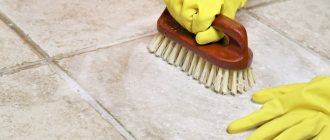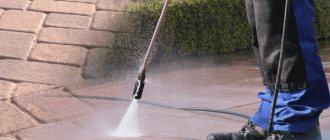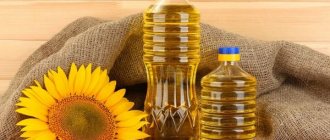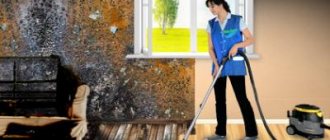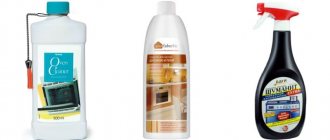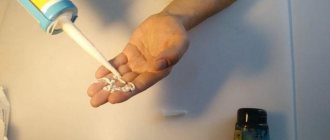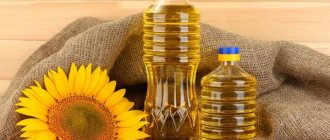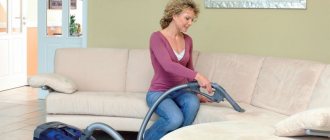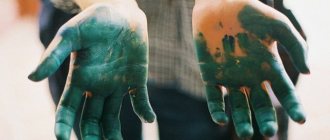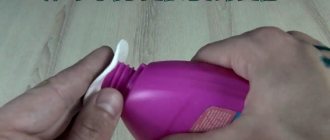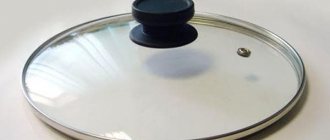Paving slabs are made of porous material, so they easily absorb various contaminants. Machine oil leaves traces that are difficult to remove, and it is very difficult to control cleanliness. Changing the engine oil, a gearbox malfunction, and now caustic liquid is dripping from the faulty parts of the car. Dirt and debris quickly stick to oil stains. If you do not react in time, the coating must be replaced.
Experts advise starting removal work as soon as the oil comes into contact with the pavement. But in real life this is hardly possible. Most often, we notice the mistake after the oil has dried and dust has stuck on top. First, you can try traditional methods of removal, but if they do not help, then we move on to more serious chemical methods.
Why is it important to remove oil stains?
In its composition, machine oil is a liquid binder.
Once it hits concrete, it almost instantly penetrates its pores and leaves a greasy mark on the surface. It is also known that when concrete is exposed to mineral oils, a chemical reaction occurs between the weak acids contained in the oils and the cement stone. This causes an adsorption decrease in the strength of concrete. Under the most unfavorable conditions (high water-cement ratio, concrete structure with a large number of microdefects, etc.), the strength of concrete can decrease by 70% of the original. The surface of the concrete base must be free of oil stains, dust and dirt before applying any coating.
This condition is especially important to observe when applying a polymer coating, since dust and dirt prevent the adhesion of the polymer and concrete, which subsequently causes destruction of the self-leveling floor.
The absence of oil contamination of concrete is regulated by the requirements of SNiP 3.04.03-85
To remove oil stains from concrete, various mechanical methods and surface etching with special acid-based chemical compounds are used. Surface cleaning is carried out mechanically using diamond grinding wheels, cups, and cutters.
For this cleaning method, equipment of various capacities is used. But it should be taken into account that microcracks may form on the surface, which in some cases is extremely undesirable.
Chemical cleaning has a number of advantages, which is why it is becoming increasingly popular. But when using this method it is quite difficult to achieve uniform cleaning of the entire surface. When chemical cleaning, in addition to compounds, hard metal brushes are also used, and upon completion of the work, the surface is thoroughly washed with water.
When choosing a cleaning method, it is necessary to take into account the fact that the properties and quality of the concrete surface will differ depending on the chosen method. For example, after milling, the tensile strength of concrete decreases significantly, and after sandblasting it increases. Strength indicators will be even higher if wet sand is used to clean the concrete.
When cleaning a concrete surface from oil stains, several problems must be solved simultaneously:
- clean the oil in a timely manner, avoiding old stains;
- dissolve greasy stains on the surface of concrete using special means;
- wash off remaining oil from concrete;
- Avoid damage to the concrete surface during the removal of oil stains.
How to properly care for paving
In one of the articles, we wrote how to get rid of grass in the seams of paving slabs. For regular dry cleaning of debris and dust, use sweeping brushes. Do not use mechanical cleaning equipment with a metal working part; it will damage the sidewalk lining.
Carry out regular dry cleaning of debris using a soft bristled brush.
Once a month, the pavement surface should be wet cleaned with a brush or washed. When wet cleaning, direct the water stream at a slight angle to the coating.
In European countries, certain street shampoos are used for constant cleaning of tiles, which contain a whole range of active substances. They allow you to clean your sidewalk from a variety of dirt, traces of rubber, and renew the color of the coating. First, the pavement surface is wetted, then a gel is applied, after which it is washed off with water. Shampoo consumption is approximately 1 liter per 1 cubic meter. water.
Regular proper maintenance of the paving surface helps maintain the quality and good appearance of the path.
How to remove oil from paving stones
To remove minor contaminants, the surface of the paving stones is washed with pre-treatment with caustic soda and sand. After removing a stain on concrete paving stones, it is recommended to fill the remaining stained area with cement. But this technology is effective in eliminating fresh stains.
It is possible to prepare a solution for washing off oil with the addition of turpentine and ammonia. Oil stains are sprinkled with talcum powder or starch, but for large-scale cleaning of paving stones such costs are not economically viable.
The mechanical method of removing oil involves treating contaminated paving stones with a grinding wheel or a drill attachment. Sandblasting is also used for cleaning, which can damage the surface of the paving stones or disrupt the density of individual stones.
Modern technologies determine how to remove oil from paving stones by selecting a special chemical that breaks down viscous machine oil at the molecular level.
Steam cleaner
The device removes stains from tiles even in hard-to-reach places. Under the influence of hot steam released under pressure, contaminants are heated and dissolved. This method allows you to deal with grease stains, plaque, mold and neutralize spores and harmful bacteria. Upon completion of treatment, the surface should be cleaned with a damp sponge and then wiped dry.
Removing stains from floor tiles is not an easy job, and these methods will help you cope.
How to clean different types of fabrics?
When starting to remove an oil stain, you need to consider the type of clothing and type of material. Both improvised and special means can be used.
Cotton, linen
To remove oil from natural fabrics, you can use simple folk recipes. Even dishwashing gel gives good results if you use it while the stain is fresh.
Without pre-treating the stained area, items should not be washed in hot water. Otherwise, the stain will be very difficult to remove.
Jeans
Denim material has a high density of fiber weave. Oil that gets on jeans is quickly absorbed and difficult to remove. To treat such fabric, it is better not to use soap or dish gel, but rather more aggressive solutions. For example, based on acetone or gasoline. It is recommended to treat the material with solutions from the reverse side.
Suede
You will have to remove oil from suede in several stages, working gradually.
It is possible to use any of the methods that does not stain or discolor the material, and also does not spoil the texture of the suede. It could be ammonia or gasoline.
The solvent should be used sparingly, without spreading the stain over the surface of the material. At the end of the process, it is better to wash off the remnants of the products that were used to remove oil with a soap solution, and treat the suede with a special product.
Outerwear
To remove oil from jackets and other things, gasoline, laundry soap, dishwashing gel and other available products can be used.
Treatment should begin by removing excess oil and preventing the grease from spreading to the interior and lining. In difficult cases, you will have to prop up the lining in order to have access to the problem area from both sides.
It can be very difficult to clean up membrane and other things after oil stains, and the result is not guaranteed. An alternative approach is to dry clean your outerwear.
Leather
Any stains from natural leather should be removed as carefully as possible, avoiding intense exposure. To remove stains, soap, gasoline, and dishwashing gel can be used. After finishing the treatment, the skin must be treated with a special product.
This video will show you how to remove machine oil stains from clothes:
Where to begin?
Most often, clothes suffer from oil stains. An accidental mark can lead to the fact that an otherwise good piece of clothing will simply have to be thrown away. To prevent this from happening, it is advisable to begin removing traces of technical fluids as soon as possible.
It is important to adhere to two main recommendations:
- Localize where engine oil gets on the surface, preventing it from spreading over a larger area.
- Prevent oil from absorbing into the material. To do this, use preparations that can absorb the spilled product.
It is recommended to sprinkle a fresh stain on top as quickly as possible:
- salt,
- talc,
- chalk,
- starch or other powder that will slow down the absorption of oil into the surface.
After the grease has been absorbed, the powder is collected and work begins to remove traces of spilled engine oil.
It is recommended to use absorbent products in all cases where oil has been spilled. Regardless of the type of surface material.
How to remove rust stains on paving slabs?
The appearance of rust on paving slabs is inevitable. They can be caused by a standing barbecue or any other metal tool that was unexpectedly exposed to rain. So how to remove rust stains on paving slabs?
- Use oxalic acid - it is a fairly toxic substance that must be dissolved in water. It reacts with iron oxide not only on the surface, but is also “absorbed” into the tile.
- Regular dish soap will work for removing small rust stains on your pavement - just apply it to the problem area and scrub thoroughly with a brush.
- You can also clean paving slabs using a special chemical that can be found in hardware stores.
How to restore the color of paving slabs?
Over time, the color of paving slabs fades - this is due to exposure to sunlight or mechanical damage. Very often, in places where a car or trolley constantly passes, tiles lose their appearance. In order to return the tile to its former beauty, you can paint it or try to wash it.
How to restore the color of paving slabs?
- If the color has changed due to the fact that the tile has never been washed and has become very dirty, everything is very simple. With the help of cleaning products and detergents it will be very easy to return it to its original appearance.
- If the tiles have become dull due to damage, it is best to paint them. For this purpose paint is used. It should be applied in one or two layers, depending on the desired color density.
Products for cleaning paving slabs
Regular washing of paving slabs will help you avoid heavy contamination and always keep them in good shape. To care for tiles that have no visible dirt, use plain water - wash them daily under high pressure from a hose. In addition, you can now find special products for washing paving slabs - the various components included in their composition will help not only wash the tiles, but also prevent the deposition of dust and small debris on it.
You can also find out prices for paving slab laying services from us.
Advantages and disadvantages
Features of cleaning
If you properly care for the tiles and promptly remove surface contamination that appears on them, then there will be no special problems with the coating - it will last a long time. In any case, paving stones require periodic cleaning. Which of the presented types is the most optimal if you compare the pros and cons of each option:
- The chemical option not only removes stains, but also prevents grass from appearing between the tiles.
- Too aggressive chemicals can damage the tile surface or even destroy individual elements.
- Mechanical cleaning takes a lot of time and is not always effective.
- Mechanical or chemical cleaning is not carried out in winter, as the chance of damage to the material increases.
- Thanks to mechanical cleaning, you can get rid of most types of stains and dirt.
- Paving stones will be perfectly cleaned of old stains and general dirt thanks to mechanical influences, if carried out regularly.
Note! A particularly effective option would be a combined type of cleaning - mechanical + chemical.
If you initially lay a cheap version of the tile, then any type of cleaning will become a dangerous impact with disastrous consequences. You need to be especially careful when removing crusts of ice and snow from the tiles during the cold season.
How to remove using traditional methods?
You can try to remove traces left by machine oil using improvised means.
Laundry soap
Soap is the most gentle way to remove stains, but a good result is only possible if the stain is fresh. Procedure:
- rub the affected area with soap;
- put the item aside for 3 hours;
- rub the treated area intensively with a brush using hot water;
- wash in the usual way.
Re-processing may be necessary.
Dishwashing gel
A gel containing fat-soluble components can help remove stains, but only if a little time has passed.
Application procedure:
- Apply the product generously so that the gel covers the entire stained area and saturates the fabric.
- Leave for at least 2-3 hours.
- Rub with a brush.
- Rinse.
- Wash the product.
Toothpaste
For fresh stains, toothpaste can be used. The product is applied generously to the area, rubbed, and after a couple of hours washed in warm water.
Toothpaste will not remove old oil stains, but may discolor the material at the site of application if the exposure is long enough.
Ammonia
Ammonia is often used as a solvent. Before use, the drug must be diluted with warm water in a 1:1 ratio. The material is actively moistened with the solution and left to act for 15-30 minutes. After which they wash it.
It is possible to remove machine oil stains in this way only if they are fresh.
Ironing
You can try to eliminate the oil by heating the affected tissue. For these purposes, you will need paper napkins with high absorbency.
Procedure:
- place the napkins on both sides of the area of contamination;
- iron the fabric through several napkins;
- Continue the process, replacing soiled napkins with clean ones as necessary.
Heating fabric stained with machine oil may be accompanied by the release of a specific unpleasant odor.
Petrol
Refined gasoline can be used as a solvent. Baking soda and liquid soap are also useful for removing stains.
Procedure:
- Combine liquid soap and gasoline in equal proportions.
- Stir.
- Apply the composition to the stain.
- Leave to act for 1-1.5 hours.
- Rinse off.
- Sprinkle baking soda on the contaminated area.
- Leave for 10-15 minutes.
- Rinse off.
- Wash.
Kerosene or acetone can be used instead of gasoline.
How to remove with special preparations?
Even such complex marks that machine oil leaves on clothes can be removed. For these purposes, stain removers are used that are active against greasy marks from technical fluids.
Dr. Beckmann
The stain remover made in Germany is available in liquid form in small packages. The product is suitable for removing marks left on fabric:
- machine lubricant,
- oil,
- bitumen.
The drug can be used to treat things of adults and children.
For the composition to work, the stain is well wetted, covered, and the product is allowed to lie. In this case, the surface of the fabric should not dry out. As a result of processing, machine oil dissolves and can be removed with tampons and napkins. The area of material is wiped with a rag. After the oil is removed, the textiles are washed.
The product is not suitable for treating carpeting and leather items . The average price is from 200 rubles per bottle.
Astonish Oxy Active Plus
The drug, produced in Great Britain, is available in concentrated form. The product contains no phosphates. The powder can be used to wash clothes for children and adults made from various types of fabrics.
Astonish powder can be used to remove difficult and old stains. In addition to clothes, the stain remover helps clean:
- furniture upholstery,
- floor and wall tiles,
- carpets and other surfaces.
The product comes with a measuring spoon, which makes dosing easier. Price – from 150 rubles per 0.5 kg package.
Liqui Moly Auto-Innenraum-Reinger
Automotive cosmetics - car interior cleaners - work well with machine oil on fabrics and other surfaces. The drug TM Liqui Moly is available in liquid form in bottles with a sprayer. It removes traces of machine oil well and refreshes the material.
To clean the fabric from stains, the product is sprayed onto the problem area, and this action is repeated if necessary . During the cleaning process, do not allow the liquid to dry on the material. Price – from 800 rubles.
How to clean porcelain tiles on the floor after renovation
After repairs, stains remain on porcelain tiles that are difficult to remove with plain water.
Contamination of tile floors after construction work is very disappointing. Its surface is capable of reacting to the composition of the cleaning agent, depending on the raw materials used in production.
Clinker tiles are formed using the extrusion method or wet pressing, after which they are fired for a long time at high temperatures. Porcelain stoneware is made by semi-dry pressing, and then, just like clinker stone, it is subjected to long-term firing. These types of products are universal in use. They are used for cladding facades, laid on floors and walls in apartments and houses, and widely used in landscape design.
After repairs, you can thoroughly clean the floor tiles from dirt using an industrial solution purchased in a store, or you can prepare a cleaning composition yourself.
Several products are suitable for cleaning porcelain tiles. Including liquid for cleaning bathrooms, hydrochloric acid, glass cleaner.
Tools at hand that can be used to clean up a tiled floor:
- Liquid for cleaning bathrooms. Apply this mixture onto the stains several times.
- Table salt - pour it over the dirt stains and moisten with water.
- 5% hydrochloric acid - treat the tiles with it.
- Windshield cleaning fluid - treat dirt, then wipe.
- Tooth powder – sprinkle on stains, add a small amount of water, clean with a stiff brush.
If you can’t wash it with improvised means, buy a special solution to combat a specific type of contamination. Please read the instructions for use carefully.
Rust removal
In some situations, traces of rust may appear on paving slabs. For example, the impact of a special equipment bucket on a paving surface leads to the formation of scratches and chips on the tiles, which over time become pigmented with iron particles and acquire a rusty tint.
Rust can also appear in raw materials for the production of paving stones (sand), as well as in pallets in a finished product warehouse when stored in several tiers. When exposed to rain, metal nails in transport pallets rust and the resulting solution flows onto the underlying rows of products, coloring them with yellowish stains.
MS-Rost EX is successfully used to remove rust.
. It should be borne in mind that the components included in the cleaner react with concrete, which can lead to the washing out of particles of coloring pigment (on colored tiles) and exposure of aggregate grains. Therefore, immediately after using the product, it is necessary to rinse it thoroughly with plenty of water.
.
Methods for removing machine oil from tiles
- Mechanical method. A greasy oil stain covered with dirt and dust is cleaned using a scraper, spatula, metal mesh, or hand-held power tools. Remaining stains that have been absorbed between the joints and into the top layer of the tile must be thoroughly washed with soapy water. The disadvantages of such removal are that the oil embedded in the porous structure of the tile is not completely removed.
- Adsorption method. Cover the spilled oil with dry sand or cement. After an hour, sweep and clean the entire surface. It is also advisable to rinse with water. The disadvantages of this method are that only fresh oil is removed this way. How to remove machine oil from tiles with protruding relief if the oil remains in the recesses?
- Washing method. Considering the quality of engine oil, which contains various additives, you can use organic solvents (such as white spirit) to wash it off, and then add detergents that break down fats to the water. Disadvantages: the tiles will have to be washed thoroughly, which can destroy the joints in the masonry. Scratches, cracks and chips appear on the tile itself. Due to constant washing and rubbing, the tiles begin to crumble.
- Chemical method. A special chemical allows you to remove machine oil from the tiles easily and quickly. All you have to do is apply the finished product to the contaminated areas, wait for the time specified in the instructions, and then wipe the tiles with a soft cloth.
Benefits of a chemical machine oil remover
- Acts only on fatty compounds of machine oil;
- Easy to apply to horizontal and vertical surfaces;
- Suitable for cleaning all types of tiles;
- Removes fresh and dried oil stains;
- Sold in economical packaging at affordable prices;
- Environmentally safe;
- Has a quality certificate.
Recommendations
For more efficient work, it is recommended to adhere to the following tips:
Gentle machine oil removers may have little or no effect on old stains.- Before using the solvent, you need to study the instructions for it.
- Older stains may need to be treated several times. And even in this case, the result may not be the best.
- Most engine oil solvents have an aggressive composition. In order not to spoil the item, it is recommended to test it on an inconspicuous area before using the product for the first time.
- Even after removing the stain, a specific technical aroma may remain on the clothes for some time. To completely eliminate it, the item needs to be well ventilated.
- Worn fabrics may not withstand intensive cleaning. If an item has a significant degree of wear and tear, it will simply have to be thrown away.
The result of removing an oil stain largely depends on the thickness of the composition and brand of the product, as well as how long ago the stain was placed.
If you are interested in how to remove vegetable and machine oil stains from various surfaces, take a look at this section.
Cleaning and disinfection
Use warm water and dishwashing detergent to wipe. Fill a sink or small bucket with warm water. It is best to use warm water to clean granite. Add some liquid mild dish soap and stir the water lightly until it dissolves.
The exact proportion is not important. Just make sure the water becomes a little soapy.
Wipe the countertop once a day with a clean white cloth. To clear the countertop, remove all appliances and dishes from it. Soak a rag in the dish soap and water solution, then squeeze out the excess water. Wipe off all crumbs and other food debris from the countertop.
Mix alcohol with water to disinfect countertops. Fill a spray bottle with water and 91 percent isopropyl alcohol in a 1:1 ratio. Screw on the cap and gently shake the bottle to mix the alcohol with the water.
Spray the countertop with a disinfectant solution every few days. Use a spray bottle to spray the solution evenly over the surface. Apply the solution to the entire countertop and do not skip individual areas. Wait 3-5 minutes for the disinfectant solution to take effect.
You don't have to leave the solution on the countertop if you don't intend to disinfect it.
Dry the countertop after wiping off the solution. Dip the rag into the soapy water again. Wipe down the countertop to remove any disinfectant solution. If desired, you can then wipe the countertop with a cloth soaked in clean water.
Wipe the countertop with a dry cloth to give it a shine.
Do not use acidic cleaners on granite surfaces. Products containing ammonia, vinegar or lemon juice contain acid and can damage granite. However, you can use citrus essential oils as they have a neutral pH level.
Removing splashes and stains
Blot up any spilled liquid with a paper towel. If you spill something on the countertop, immediately blot up the liquid with a paper towel. Do not rub the liquid over the surface. Even plain water can stain granite, so the liquid should be removed immediately.
Use a clean paper towel to avoid further contaminating the surface. You can also use a clean microfiber cloth.
Use hot water and a little dish soap to clean up spills. Fill a mug or heatproof cup with hot water. Add a few drops of mild dish soap and stir the water until it dissolves. Pour some solution onto the stained area and wipe it off with a clean microfiber cloth.
Repeat until you get rid of the stain.
Use a baking soda paste to remove the oil stain. Take a small cup and use a spoon to mix three parts baking soda and one part water. Apply the resulting paste to the contaminated area and rub it with a clean cloth.
This mixture will also help remove old oil stains.
Try removing juice or water stains with hydrogen peroxide. If the liquid has left a stain on your countertop, mix three parts hydrogen peroxide to one part water. Pour the solution onto the dirty area and rub it with a clean rag.
Rub the solution in light circular motions.
Wipe the surface with water. Dampen a clean rag with water and rinse off any remaining cleaner from the granite surface. Wipe down the countertop until all dirt and cleaner are removed.
Wipe the countertop with a dry microfiber cloth to remove any remaining water.
Protective layer to prevent stains
Check the protective coating. Splash water on the granite surface and see how it behaves. If the water beads up, the coating is intact. If water spreads over the surface, it’s time to renew the protective coating.
The coating protects the granite surface from chips and stains.
Clean and dry the countertop thoroughly. Use a cleaner specifically designed for granite. You can buy it at the store or make it yourself from alcohol, dishwashing detergent and clean water.
- Wipe the countertop with cleaner, followed by a clean microfiber cloth dampened with warm water.
- Wipe the countertop with a dry, clean microfiber cloth.
Cleaning tile joints
The grout that fills the seams between the tiles darkens over time, becomes covered with brown stains, and fungus loves to settle in it - both green and the most dangerous black.
When cleaning the kitchen daily, the seams are washed well, but if cleaning is not done every day, the kitchen becomes very untidy. What can help in this case?
Reference. To deeply clean the surface, you can use either a toothbrush with stiff bristles (you can buy the cheapest new one or use an old, unnecessary one), or a melamine sponge, or a special brush for tiles.
The cleaning products used are the same as for tiles, but to prevent the appearance of mold and remove existing mold, you should use a mixture of soda, water and vinegar.
Too acidic solutions can slightly “loose” the solution inside the joints, so there is no need to pour a lot of vinegar into the water.
It is also strictly forbidden to use very hard bristles on brushes and metal sponges - they not only scratch the gloss, but also wash out parts of the solution from the seams.
After such “cleaning”, mold and dirt will eat into it even more and it will become impossible to wash them off.
We use cleaning products wisely
You can remove debris and other stains from paving stones using strong and effective products. It should be remembered that aggressive substances in the composition can discolor the coating, so first you need to test the product on a small area of tiles.
In the presence of efflorescence
Efflorescence is a white line that often appears on paved surfaces. They are formed due to exposure to liquid, resulting in a light coating on the tiles. You need to get rid of it, as it contributes to the appearance of fungus and destruction of the coating.
Efflorescence can only be removed using chemicals:
- Products that do not contain harmful substances. This type of drug is diluted with water in a ratio of 1:10.
- Orthophosphoric acid. Dilute with water at the rate of 1 liter of product per 10 liters.
- Household chemicals (“Whiteness”, “Chistin”, etc.). Dilute with water in a concentration of 1:10.
How to clean dirt from paving slabs:
- First, the surface must be rinsed with a strong stream of water to remove small debris and dust.
- When the tiles are dry, the chosen cleaning product is applied to them.
- After an hour, the chemical must be washed off with water and the coating wiped dry.
In the future, applying a hydrophobic composition will help prevent the formation of efflorescence.
In the fight against mold
Mold covering paving slabs looks untidy and also shortens the life of the coating. Therefore, when you notice the first signs of mold, you should immediately begin the fight. The less time passes from the moment the plaque forms, the easier it will be to deal with the problem.
The following remedies will help destroy mold:
- Bleach used to wash clothes.
- Bleaching.
- Special products designed to combat this type of pollution.
The procedure includes three stages:
- Contaminated areas are treated with the selected product.
- Using a stiff brush, rub the product into the tiles in a circular motion.
- After ten minutes, the chemical is washed off with plenty of water.
If after carrying out the work mold remains are still visible on the surface, the procedure should be repeated.
How to clean cement from paving slabs
If cement dust acts as pollution, then cleaning the paving stones is not difficult. To do this, you just need to sweep away the dust with a broom, and if a wet solution gets on the coating, then use a clean rag. However, if the cement has time to set, then you can only get rid of drips and traces of building material using special chemicals. They contain phosphoric acid, which successfully copes with this type of pollution. After use, it is necessary to neutralize its effect with ordinary soda or ammonia and rinse with water.
An equally important question is how to clean colored paving slabs from cement, especially if it has already hardened. In this case you will need:
- brush with stiff bristles;
- hammer;
- chemicals.
First, mechanical cleaning is used - using a hammer and chisel, the hardened cement is crushed, and then a brush is used, removing the remaining small particles. You need to work very carefully so as not to damage the coating. The remaining cement is treated with special chemicals.
We eliminate other pollution
In addition to efflorescence and mold, other types of contaminants may appear on the sidewalk surface. These include:
- oil;
- dye;
- black marks caused by the interaction of car tires and tiles;
- rust, soot, chewing gum, etc.
Country property owners regularly have to deal with various stains, as well as weeds and other unpleasant things that give the paving stones an unkempt appearance. You can deal with them as follows:
- Grease stains from the coating are easily removed with alkali. You can try to wipe off oily ones with sand - just sprinkle it on the area and collect it with a rag or sweep it away. The cleaned surface is treated with soda and washed with water. If the oil has already been absorbed, then special products will come to the rescue: “Antex 2”, “Oil Killer”.
- Soot and tire marks are removed with hot water and pavement cleaner.
- Oxalic acid perfectly removes rust. It is applied to the stain, rubbed in and washed off with a strong stream of water.
- Cured paint can be carefully scraped off with a spatula, and the remaining residue can be removed with a solvent.
- Chewing gum can be easily removed with a regular knife. You can make the process easier by placing a couple of pieces of ice on the chewing gum.
Knowing how to remove dirt from paving slabs, you don’t need to worry about stains - just treat the surface with special products, and clean paving stones will please the eye for a long time.
Classification of contaminants and cleaning methods
Unlike common areas paved with paving slabs, garden paths, recreation areas and parking areas are less susceptible to contamination. However, here too, FEM elements become unusable or lose their artistic value due to the following contamination:
In recreation areas, it is additionally necessary to clean the sidewalk surfaces from chewing gum.
The main cleaning methods are:
Mechanical cleaning of tiles.
Important! Pressurized water is used to clean and rinse off reagents at the end of work. Therefore, it is necessary to periodically restore the level of filling of the joints with sand if the inert material was accidentally removed from there.
Cleaning tiles from cement (plaque and mortar)
Cement and products based on it are especially dangerous for shaped paving elements made by vibration compaction:
There are several main reasons for cement embedded in the front surface:
Sedged cement on paving slabs dramatically reduces the aesthetics of the exterior.
Depending on how much time has passed after laying, or contact of cement with the rough surface of the paving lining, the following products can help:
Cleaning FEM from cement.
A more complex option is the sandblasting technique. The disadvantage of this method is that the thickness of the tiles decreases, which negatively affects the overall service life of the coating.
Drops and cakes of the solution are first cleaned from the paving slabs with a chisel, abrasive disc or metal brush. After which cleaning is carried out using the above methods.
Efflorescence
Unlike brickwork, where the culprit is the mortar under the ceramic, efflorescence on paving slabs appears due to additives in the cement or impurities in the very structural material from which the tiles are made.
Reasons for education
Efflorescence owes its occurrence to several reasons:
Efflorescence on the surface of the FEM may occur even before installation.
Mostly the efflorescence on the front side of paving slabs contains chemical compounds:
The owner of a country property can bring the wheels of his car into the parking lot with chemicals that road services use to combat ice. Some of them weather naturally, others do not dissolve in water, have high adhesion to the base, and penetrate several mm into the concrete structure.
Elimination methods
Don't wait for the efflorescence to disappear on its own. You can prevent their occurrence with silicone water repellents, but before doing this, the tiles must be cleaned of dust and at least dried by the sun. The procedure allows you to forget about efflorescence for 3–4 years, depending on the intensity of pedestrian traffic.
You can remove salt deposits that spoil the design of garden paths in the following ways:
Biodegradable preparations are usually dissolved in a ratio of 1:10; after application, concrete surfaces receive the effect of a wet surface, emphasizing the texture of even unpainted paving slabs. The salt deposit is removed entirely, the surface increases moisture resistance without additional treatment.
Dark spots
In certain areas of the paving area, dark spots appear on the paving slabs, which are not considered pollution, but can reduce the aesthetics of the decorative coating.
Reasons for appearance
Unlike other defects in FEM elements, the owner cannot determine the reasons for their occurrence. No liquids were spilled in these areas, and no construction work or equipment repairs were carried out.
The cause is usually capillary suction of soil water or excess saturation with rainwater:
Dark spots on the paving stones.
This visual effect is also often observed in freshly made tiles stored in conditions of high humidity, for example, covered with polyethylene.
Elimination methods
To remove dark spots and prevent them from appearing in the future, significant effort will be required:
In the first case, you will have to dismantle the paving surface and replace the layer of sand under the contact layer on which the paving was made with crushed stone. This is complicated by the fact that the paving slabs could have been laid on a concrete compound (CPS mixture), in which the cement has already undergone the hydration process. Therefore, you will have to completely dispose of the garnet and lay the tiles on screenings or coarse sand with high drainage properties.
Oily stains
Most often, greasy stains are found near fireplaces and in rest areas from barbecue and ice cream, respectively. It is not always possible to wash them off with soapy water and detergents, so special preparations are used.
Causes
In addition to careless handling of food and prepared meals, greasy stains occur when carrying bags or transferring these substances to the shoes of residents. Pets also cause such pollution.
Grease stains on paving slabs.
How to delete
It is easier to remove a mark from a hard greasy piece that has fallen on a tile than from a puddle of vegetable oil. Folk remedies for greasy stains on concrete are traditionally considered:
In difficult cases, concentrated chemicals should be used. For example, HG cleaner is applied to the surface, which is wetted when drying for an additional 5 minutes. After that, just rinse the tiles with water.
Fuel stains
Unlike vegetable and animal fats, stains from fuels and lubricants are much more difficult to remove from the surface of concrete. If the spilled stain is detected by the owner immediately, the chances of eliminating the defect are quite high:
Attention: After several hours, diesel fuel/gasoline can be deeply absorbed into the structure of the material; even chemicals will not help - Oil Killer or Bremsreinieger liquid, used for similar cases at gas stations.
The shaped paving elements are interchangeable, so the defective tiles are split, the fragments are removed, and new FEMs are laid in their place.
Traces of treads and paintwork
Dark stripes from car tires can be removed from the surface of parking lots with ordinary detergents or solvents for paints and varnishes. To prevent chemicals from destroying the concrete structure, areas are washed with hot or cold water.
Spilled paint and potassium varnish, other paintwork materials are eliminated with solvents (464, Whitespirit) or special compounds. The technology looks like this:
Chewing gum is easier to remove after freezing or with cleaning products after scraping. For example, you can cover it with ice or try to wet it with Decap Salts Guard.
Thus, most contaminants are removed from paving slabs without compromising the integrity of the decorative coating layer. However, in difficult cases it will be necessary to replace one or more figured paving elements entirely.
Traditional methods
If you decide not to use special products, you can turn to effective folk methods. Regular citric acid will help in removing the building composition from the surface after it dries.
Often, a paste mixture containing baking soda and vinegar is also used to wash off dried grout. The components are mixed in equal proportions and the contaminated areas are treated with the finished composition.
The product is applied to the stain and left to act for several minutes. After this, the paste is removed using a soft sponge or brush.
You can also wipe off frozen fugu using simple baking soda. To begin with, the cladding needs to be slightly moistened using a spray bottle filled with water or a damp cloth. After this, you need to apply a small amount of soda to the tiles. Then wipe the lining with a soft brush, without making sudden movements.
You can also use baking soda to treat tile joints. This will be an excellent prevention of mold or mildew. After the procedure, the treated tiles should be washed with clean warm water.
You can clean the matte surface using regular dishwashing detergent. The gel is diluted in water, after which the tiles are washed with a sponge. Then traces of the gel must be removed with a cloth soaked in warm water.
You can clean the grout from relief tiles using glycerin. The substance is diluted in water (1 part of the substance to 3 parts of clean liquid). The composition carefully cleans the surface without leaving stains or streaks.
Another simple folk method is to use an ammonia solution. One tablespoon of the substance is diluted with water, after which the contaminated area is wiped. As soon as the grout completely disappears from the surface, the tiles must be treated with clean warm water.
To clean porcelain tiles, it is better to use white spirit. The composition (1 tbsp) must be dissolved in one glass of water. Remains of grout are removed from the surface using the prepared solution and a soft sponge.
The hardest thing to clean is a fugue with epoxy resin. This component makes the building composition absolutely invulnerable to organic acids and various alkalis. This is why it is necessary to use special cleaners to remove grout. Apply a softening agent to the areas of contamination and after 10 minutes remove the remaining mixture with a brush.
Regular paving maintenance
For regular dry cleaning of debris or dust, you can use dry brushes, sweepers or garden vacuum cleaners (such as Karcher, STIHL, etc.)
. It is strictly prohibited to use tools or mechanized cleaning equipment with a metal working part, which could damage the top layer of the pavement.
Once a month, paving slabs require wet brushing or washing
. When wet cleaning, it is recommended to direct the water stream at a shallow angle to the coating in order to minimize any risk of damage to the tile joints (if the joints are damaged, it is necessary to sprinkle them with sand).
In European practice, so-called street shampoos are used for regular cleaning of the coating.
, which are a complex of surfactants that allow you to clean the surface from dirt, traces of rubber and refresh the color of the coating. Initially, the surface of the sidewalk is moistened, then shampoo is applied, and then washed off twice. Shampoo consumption is on average 1 liter per 1 m3 of water.
Timely and proper care of laid paving slabs (cleaning, washing, filling exposed seams) helps maintain the quality and durability of the coating!
Do I need to remove oil from paving stones?
Motor oil gets onto the road surface made of paving stones from cars passing and parked on the side of the road. Splashes of recycled oil may come out of the exhaust pipe and also leak out of the engine due to technical reasons. For a car this is a dangerous phenomenon, and for paving stones it is an environmental disaster. The beautifully laid out pattern on the pavement becomes covered with greasy stains.
In addition to surface pollution, fumes from synthetic oils increase the level of smog in the city and also affect fire safety.
The question of how to remove oil from paving stones is becoming relevant for all city residents.
Soda
Baking soda can effectively combat serious stains, including grease. The method of use is quite simple - you need to wet the sponge, periodically dip it in the powder, and rub the surface of the tile. It is necessary to clean stains thoroughly, but without making much effort, so as not to scratch the tile.
Baking soda and vinegar can be used together. The combined reaction of these components softens hard deposits of plaque and dirt.
Removing handle stains from leatherette and leather products
How to choose the right product
Before starting to remove a stain, the product is selected taking into account the type of fabric and its color.
The following rules must be observed:
- A product made of dense natural fiber fabric, nail polish remover or white spirit is suitable. A cotton pad is thoroughly soaked in a suitable product, applied to the stain and left for 20 minutes. Residues of product and oil are removed by washing with washing powder.
- For jeans, you need to prepare a special mixture of equal parts of turpentine and ammonia. You need to dip a sponge into the product and then saturate the contaminated area. Repeated washing with washing powder will be required, as the mixture has an unpleasant odor.
- Dark delicate fabric can be easily washed using diluted mustard powder. The paste is left on the stain for 20 minutes. Shake off the product and wash the product.
- A light, dense fabric can be cleaned from machine oil stains using toothpaste. A medium-thick layer is applied to the contaminated area and left until completely dry. The resulting crust is removed and the item is washed as usual.
Even if you carefully follow all the recommendations, the stain may remain on the material. Don't throw the item away right away. At a dry cleaner, specialists will select the right product based on the type of fabric, condition of the clothing and the age of the stain. If the material is treated with water-repellent impregnation, then removing machine oil will not be difficult, but there are fabrics whose fibers instantly absorb oil. A deeply ingrained stain can be removed, but it will require more effort and time.
The presence of a car in the family means that from time to time the question arises of how to wash diesel fuel from the jacket and jeans in which the beloved man was fiddling with equipment. It is better to solve such a problem immediately after contamination is detected, since any technical mixture after drying is difficult to remove from the fabric.
- Salt, lemon juice and oil
- Detergents and soda
- Gasoline and ammonia
Diesel fuel is diesel fuel obtained by direct distillation of oil. If fuel gets on clothing it leaves yellow and very greasy stains. But even without the use of any specialized products, such stains can be washed off at home.
Rules for working with cleaning products
Most grease removers - both homemade and store-bought - can cause an allergic reaction, poisoning, or, if actively inhaled, a lung burn.
To work with household and folk chemicals, you must strictly follow the safety rules:
- Cover your clothes with a long, thick apron;
- be sure to wear rubber gloves;
- do not lower your head low to the surface to be cleaned so that the acid vapors do not burn your throat and lungs;
- read the instructions for the purchased product;
- remove all food products from the table and kitchen counter;
- Make sure that children and pets do not have access to the kitchen.
After cleaning, wash your hands, face and neck very thoroughly, it is even better to take a shower with shampoo and soap. Rinse the gloves thoroughly, wash the apron in the machine. After cleaning the kitchen, it is better to immediately throw all clothes into the washing machine.
Before work, it also makes sense to make sure that the window in the kitchen is open, and if possible, you should also turn on the hood. You should not inhale fumes from household chemicals or vinegar - they can cause a real burn to the larynx and mucous membranes.
After washing the tiles, the window should be left open for at least 30 minutes in winter, and for two hours in summer, so that all the toxic fumes are blown outside.
Why do you need to clean concrete and asphalt surfaces from fuel and lubricants contamination?
- Violation of the environmental component of both the external environment and inside the garage.
- Reducing the fire safety level of the premises.
- Reduced coating strength.
I would like to dwell on the last point in more detail, because for a lazy person it’s hard to think of better motivation than a powerful kick to his wallet. The fact is that exposure to petroleum products causes a weakening of intercomponent bonds in concrete or asphalt coatings. The same picture applies to paving slabs.
High molecular weight resins contained in used motor oil can easily seep into the smallest pores and cracks. The greater the porosity of the coating, the faster its impregnation occurs.
Studies have shown that temperature fluctuations further aggravate the situation - the strength of samples after a year of saturation with oils decreased by 7%. After this, like it or not, you will have to think about how to remove oil from asphalt, and the sooner the better.
At the same time, there is good news - kerosene or gasoline do not affect the strength characteristics of concrete, which, however, cannot be said about asphalt pavement. But for a thrifty owner, the aesthetic component will be enough - when he sees an oil stain in the garage, he will immediately rush to look for ways to get rid of it. This is where our advice will help him.
Chemical pollution control
Chemical tile cleaning options
If cars are being repaired in the yard, the tiles will be the first to suffer from contamination. If we turn to the type of chemical exposure, the question arises as to how to wash machine oil from paving slabs. There are several simple but effective remedies:
Exposure to rust stains and oil paint residues is often required. Remove old paint stains from the surface mechanically, scraping off the base of the stain with a spatula. Residues are removed with detergent and solvent. Absorbed residues are removed with a solution of hydrochloric acid. A solution of oxalic acid will help remove rust stains.
Thanks to this option of influencing pollution, the laying of paving stones is not disturbed, but you should not overuse chemical solutions.
Determining the cleaning method
The reason for contamination of the tile covering is its porous structure. Dust, dirt, organic and chemical liquids easily penetrate into microscopic holes. Partially retained in the pores, these substances are not easily removed. Depending on the nature of the contamination, the following methods of cleaning paved surfaces are distinguished:
- Dry. This means regular sweeping with a broom or soft-bristled broom. Such actions prevent the formation of dirt and help cleanse micropores.
- Wet. Problem areas are washed with a stream of clean water under high pressure. In the presence of fatty deposits, household and special detergents are used.
- Chemical. This implies the use of potent drugs based on alkali, acid and solvents. The principle of operation of these compositions is based on the destruction of the molecular structure of contaminants. Chemicals are effective for cleaning areas contaminated with fuels, lubricants and rubber marks.
- Mechanical. Foreign deposits are removed from the paving stones using scrapers, sandpaper or grinding machines. Then the treated areas are polished and primed.
- Thermal. The treatment is carried out with superheated steam, which softens and blows away organic matter, motor fuel and engine oil from the surface. In some cases, an open flame is used, turning the dirt into ash.
- Cryogenic. As a result of exposure to cold, many substances become brittle. After strong cooling, they crumble into small fragments that are easily removed.
Features of cleaning tiles with a textured surface StoneMix
Stones and paving slabs with a washed StoneMix front surface can be subject to severe contamination due to the entry of dirt, clay and black soil into the voids between the grains of the exposed aggregate. Thus, the textured grainy surface becomes clogged with debris, and aesthetics are lost.
To clean such stains, you can use the highly effective cleaning agent Donnitil 3 X
produced by MS Bauchemie. The product is supplied in the form of a fine powder. The concentration of the solution is selected depending on the degree of contamination of the coating. An additional advantage of this material is its ability to neutralize efflorescence on the coating. The algorithm of action of the product is similar to the principle of operation of the anti-efflorescence agents mentioned above.
conclusions
The choice of the most appropriate cleaning method depends on the initial state of the concrete surface, that is, on the degree of its contamination, the presence of corrosion products, remnants of previous protective and decorative coatings, etc., as well as on the requirements for the surface in accordance with the proposed repair and construction projects events. You can verify how suitable the chosen cleaning method is by pre-treating a small area of the surface.
Very often, when cleaning concrete, they resort to the sequential use of several methods. The use of any method is associated, to a lesser or greater extent, with damage to the concrete structure. To ensure that these damages in the final result are minimal, when cleaning the surface you should gradually move from coarser to more subtle methods of impact on the concrete surface.
A practical method for cleaning concrete from bitumen is shown in the video:
We recommend
DOCKER MAZBIT TURBO is a concentrated industrial cleaner for all types of heavy contaminants. Designed for effective quick cleaning of any surfaces: parts, components, mechanisms, plastics, general construction materials (concrete, stone, tiles, asphalt) from various contaminants of an oil-fat and petroleum nature, fuels and lubricants, lubricants, graphite, fuel oil, oil. Has no smell.
No acid. No chlorine. More details
How to clean paving stones from oil stains How to remove machine oil from paving stones
Expert advice
Many people believe that machine oil spilling or dripping onto paving slabs does not cause any harm to the coating. But it is precisely this approach that leads to environmental pollution and exceeding all sanitary and environmental standards in the urban area.
Dirty, oily sidewalks and areas near gas stations, service stations, and parking lots should be task number one for owners to avoid:
- excessive clogging (all debris sticks to the oily film);
- cases of injuries due to slippery puddles;
- violations of environmental and fire requirements.
How to remove machine oil from paving slabs using the most effective methods?
- To remove fresh stains or splashes of machine oil, you must quickly fill the area of contamination with a dry substance - sand, cement, talcum powder. Sweep away the mixture that has absorbed the oil and repeat the process if necessary. For old stains this method is inappropriate.
- Paving slabs in places where machinery operates or repairs are carried out must be systematically washed with water, possibly with detergents. This achieves the effect, but constant humidity causes the tiles to deteriorate faster.
- Machine oil stains of any complexity and large areas of contamination must be treated with a special chemical that destroys the surface film of the oil. The chemical method of removing machine oil has proven to be effective. It prevents the destruction of the top layer of paving slabs while completely removing oil stains.
